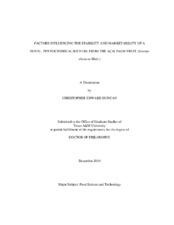| dc.contributor.advisor | Talcott, Stephen T. | |
| dc.creator | Duncan, Christopher Edward | |
| dc.date.accessioned | 2012-02-14T22:18:31Z | |
| dc.date.accessioned | 2012-02-16T16:12:06Z | |
| dc.date.available | 2012-02-14T22:18:31Z | |
| dc.date.available | 2012-02-16T16:12:06Z | |
| dc.date.created | 2010-12 | |
| dc.date.issued | 2012-02-14 | |
| dc.date.submitted | December 2010 | |
| dc.identifier.uri | https://hdl.handle.net/1969.1/ETD-TAMU-2010-12-8789 | |
| dc.description.abstract | The açai palm fruit has recently become the focus of numerous research
endeavors due to its extraordinary antioxidant content. However, little is known about
the fruit’s phytochemical rich oil, which is a by-product of the açai pulp. Therefore, the
aim of this study was to investigate the phytochemical content of açai oil and its relation
to oxidative stability.
A total of 206 mg/kg of chlorophylls, which included chlorophyll a as well as
four chlorophyll derivatives were tentatively identified by HPLC in crude açai oil
(CAO). Two predominant carotenoids (216 mg/kg β-carotene and 177 mg/kg lutein)
were also characterized in addition to α-tocopherol (645 mg/kg). Initial investigations
into oil stability focused upon the photooxidation of açai oil due to its significant
chlorophyll content and findings demonstrated that the increases of nonanal were
observed when phospholipids and polyphenolics were reduced. Subsequently,
investigations into the interactions between phospholipids and lipophilic antioxidants
and their contributions to the stability of açai oil were also assessed by isolating
phytochemicals and selectively reconstituting the oil. Findings demonstrated a potential relationship between phospholipids and lipophilic antioxidants, but this was not
conclusive.
Advances in the processing of the açai pulp by-product created from the
clarification process yielded a partially refined açai oil (RAO). The stability of both
RAO and CAO as a result of autoxidation were compared to other common food oils
(olive, canola, and soybean) and primary and secondary oxidation data suggested CAO
was most stable. The difference in the stability of the two açai oils was also investigated
by blending these oils and assessing oxidation. An increased stability was demonstrated
in the blended RAO, which suggested a significant antioxidant contribution from the
CAO. With such similar lipophilic compositions in CAO and RAO, it is theorized that
the driving factor behind the stability of CAO can be attributed to its water soluble
antioxidant content.
While further investigations are required to fully comprehend the interactions of
açai oil phytochemicals, these experiments provide insight into the phytochemical
content and stability of açai oil. The understanding and information obtained in these
studies is geared at increasing the marketability of açai oil as a food ingredient. | en |
| dc.format.mimetype | application/pdf | |
| dc.language.iso | en_US | |
| dc.subject | Acai | en |
| dc.subject | Acai oil | en |
| dc.subject | lipid oxidation | en |
| dc.subject | crude oil | en |
| dc.subject | antioxidants | en |
| dc.title | Factors Influencing the Stability and Marketability of a Novel, Phytochemical-Rich Oil from the Açai Palm Fruit (Euterpe oleracea Mart.) | en |
| dc.type | Thesis | en |
| thesis.degree.department | Nutrition and Food Science | en |
| thesis.degree.discipline | Food Science and Technology | en |
| thesis.degree.grantor | Texas A&M University | en |
| thesis.degree.name | Doctor of Philosophy | en |
| thesis.degree.level | Doctoral | en |
| dc.contributor.committeeMember | Taylor, Thomas M. | |
| dc.contributor.committeeMember | Riaz, Mian N. | |
| dc.contributor.committeeMember | McDonald, Thomas J. | |
| dc.type.genre | thesis | en |
| dc.type.material | text | en |


